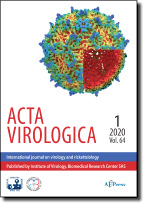Acta Virologica Vol.59, No.3, p.276-283, 2015
|
| Title: Analysis of different HCV NS4B domains for the development of global consensus sequence |
| Author: H. KHAN, S. MURAD |
|
Abstract: The non-structural 4B (NS4B) protein of hepatitis C virus (HCV) is a hydrophobic protein implicated recently in the formation of membranous web, a platform for the formation of replication complex and thus is potential target for antivirals. The CLC main workbench was used to generate genotype-specific consensus sequence, global consensus sequence and a representative phylogenetic tree from non-structural 4 B (NS4B) protein sequences of seven different HCV genotypes reported from all over the world. The C-terminal domain (CTD) of NS4B protein especially the residues involved in interaction with ER membrane were found to be highly conserved. Other residues found to be highly conserved across all HCV genotypes included; 5 aromatic residues of N-terminal domain (NTD) (F49, W50, W55, F57, and Y63), 3 hydrophobic leucine residues (L237, L240, L245), and 2 positively charged residues of CTD (R248 and H250), dimerization motif of transmembrane domain 3 (TMD3) (G143YGAG147) and its surrounding residues (F118 and F155) and TMD1 Ser/Thr cluster residues (T87, S88 and T95) involved in the hydrogen (H) bond interactions. In short, amino acids of NTD, TMD and CTD domains involved in the membrane association/anchoring of NS4B and formation of membranous web are highly conserved and can serve as potential targets for antivirals and peptide vaccines. These conserved residues formed the basis for the development of five short peptides proposed to serve as potential therapeutic target. The phylogenetic analysis was particularly interesting for NS4B sequences of 3a Pakistani isolates. The high degree of variability prevented the clustering of Pakistani isolates with other sequences in phylogenetic tree, revealing geographical disparity.
|
|
| Keywords: HCV NS4B; global consensus sequence; membranous web; amphipathic alpha-helices; dimerization motif |
|
|
|
| Year: 2015, Volume: 59, Issue: 3 |
Page From: 276, Page To: 283 |
doi:10.4149/av_2015_03_276
|
|
 download file download file |
|
|
|
|
 download file
download file
